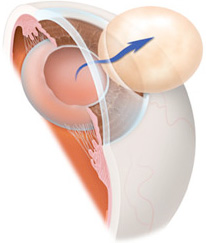Surgery is the only way to remove a cataract.
Restore Your Vision
Modern cataract surgery is one of the safest and most effective surgical procedures performed today.
What is a Cataract?
Cataracts are an inevitable part of aging and most people older than 55 begin developing cataracts. By age 80, half of all Americans have cataracts or have had surgery to have them removed. A cataract is a clouding of the eye’s naturally clear lens. The lens focuses light rays on the retina—the layer of light-sensing cells lining the back of the eye—to produce a sharp image of what we see. When the lens becomes cloudy, light rays cannot pass through it easily, and vision is blurred. It is like looking through a foggy or dusty car windshield. Things look blurry, hazy or less colorful with a cataract.
A cataract may not need to be treated if your vision is only slightly blurry. Simply changing your eyeglass prescription may help to improve your vision for a while.
Surgery is the only way to remove a cataract. You should talk to your ophthalmologist about cataract surgery when you are no longer able to see well enough to do everyday activities.
The success rate of cataract surgery is excellent. Improved vision is achieved in the vast majority of patients if the eye is healthy otherwise.
Symptoms of a Cataract
- Having blurry vision
- Seeing double
- Being extra sensitive to light
- Having trouble seeing well at night, or needing more light when you read
- Seeing bright colors as faded or yellow instead
Cataract Surgery
Your surgeon will perform a preliminary eye exam and will measure your eye to determine the correct power for your intraocular lens. You will be prescribed eye drop medicines to start before surgery and continue afterward. These medicines help prevent infection and reduce swelling during and after surgery.
Cataract surgery is done in an outpatient surgery center with surgery time lasting 30 minutes or less. During cataract surgery, your eye surgeon will remove your eye’s cloudy natural lens through a tiny incision usually not requiring stitches to close. The cloudy lens will then be replaced with a clear artificial intraocular lens. A monofocal lens implant may be used to help correct vision for one distance. Premium lens options are available to lessen your need for glasses or contact lenses after surgery.

In cataract surgery, the cloudy lens is removed from the eye through a surgical incision.





